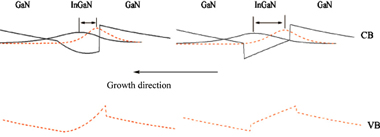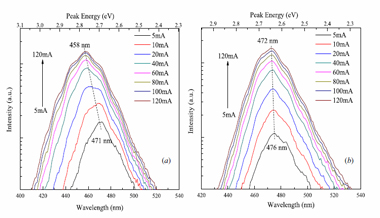
| Home | About Us | Contribute | Bookstore | Advertising | Subscribe for Free NOW! |
| News Archive | Features | Events | Recruitment | Directory |
| FREE subscription |
| Subscribe for free to receive each issue of Semiconductor Today magazine and weekly news brief. |
News
18 November 2009
Triangle wells aim to beat polarization
China-based researchers have been investigating the use of triangular shaped quantum well structures to counteract the deleterious effects of polarization fields in nitride semiconductor light emission [Li-Hong Zhu, Semicond. Sci. Technol., vol.24, p.125003, 2009].
Polarization fields arise spontaneously from the ionic charges on the component elements in the nitride semiconductor, such as gallium and nitrogen, and from strain-induced piezoelectric effects. Such fields can cause the injected electrons and holes to separate and recombine through indirect mechanisms rather than emitting light (the quantum-confined Stark effect, or QCSE).
Xiamen University researchers are seeking to overcome these effects by using triangular quantum well structure to shift the band structure and also to compensate to some extent for the polarization fields, encouraging the electron and hole wave-functions to overlap more. The triangular wells are achieved by using the growth properties of indium gallium nitride (InGaN) to construct the wells. In particular, indium is the most volatile element in the combination and tends to evaporate at higher growth temperatures.
The growth method was metal-organic chemical vapor deposition (MOCVD) on c-plane sapphire substrates. Tri-methyl-gallium (TMG), tri-methyl-indium (TMI), ammonia (NH3) and silane (SiH4) were used as the precursor/sources for Ga, In, N, and silicon (Si-dopant) with nitrogen/hydrogen as carrier gases. Conventional MQW structures were grown using constant temperatures for the various layers. Triangular structures were grown using temperatures that varied either from 680°C or 730°C up to 840°C. At the latter temperature, the resulting material contains near zero In-composition. By using different initial temperatures, one can achieve devices with varying emission wavelengths.

Figure 1: Simulated band structure of triangular quantum well (a) compared with rectangular structure (b). Solid lines indicate conduction bands and electron wave-functions; dashed lines refer to valence bands and hole wave-functions. (The wave-functions are the ‘bell-shaped’ structures).
Photoluminescence (PL) and electroluminescence (EL) experiments were carried out on the samples. While the conventional MQW structure’s integrated PL intensity fell by about two orders of magnitude (a factor of 102, or 100) between 17K and room temperature (300K), the triangular structures had emissions that fell by only a single order of magnitude (a factor of ten). This indicates that the triangular structures have higher internal quantum efficiency (IQE) even at higher temperatures.
Under an electric current, the triangular MQW samples exhibit stronger peak intensities and narrower line-widths over the conventional samples, say the researchers. The blue shift of the triangular samples with increasing current is also smaller: – 23meV compared with 74meV for the conventional sample between 5mA and 120mA. The researchers believe that the smaller blue-shift indicates the almost complete absence of the QCSE that is a feature of the performance of normal nitride-based LEDs due to polarization fields. High-current operation revealed that the triangular wells continued to increase in integrated emission up to about 300mA, rather than about 200mA for the conventional structure. This indicates a smaller efficiency droop at high currents.

Figure 2: EL spectra as a function of injection current from 5 to 120mA at room temperature for rectangular MQW LED (a) and triangular MQW LEDs (b). The emissions are in the green (520-570nm) and yellow ranges (570-580nm).
Although quantitative comparisons between the conventional and triangular LEDs have yet to be carried out, the thermal, current and spectral behavior imply that the utilization efficiency of the injected carriers for radiative recombination is much higher in the triangular MQW.
Other groups have attempted to reduce polarization fields by changing the crystal orientation of the nitride semiconductor from c-plane to another orientation where there is less polarization in that direction, such as the m-plane. This is particularly the case with recent work towards green laser diodes [see Cooke, Semiconductor Today, p.62, October 2009].Feature: Getting a green light from lasers
Visit: http://dx.doi.org
The author Mike Cooke is a freelance technology journalist who has worked in the semiconductor and advanced technology sectors since 1997.